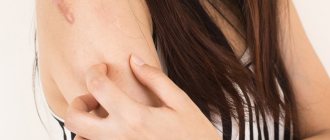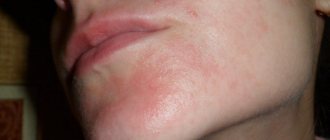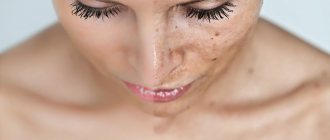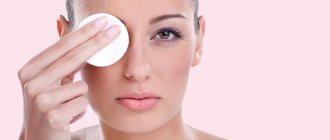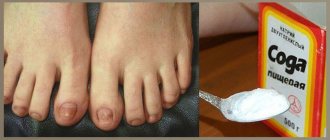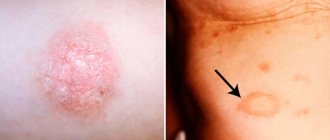Skin diseases are accompanied by obvious changes in the skin, and often dermatological problems have a similar clinical picture, so making a correct diagnosis in some cases is quite difficult.
An iodine test is a simple and inexpensive method to accurately determine a skin disease such as pityriasis versicolor and some other forms of pathology.
What kind of tests are these using iodine?
The technique was developed on the fact that staining the skin affected by lichen with a certain concentration of iodine leads to the fact that the color of the skin in the lichen zone becomes more intense.
Since during lichen the upper layer of skin is actively exposed to pathogenic microorganisms, it begins to have increased conductivity, therefore, the degree of penetration of the iodine solution increases significantly.
Thus, specialists are able to identify areas with pathogenic microflora and make the correct diagnosis.
Important!
The Balzer test (iodine test) does not require preliminary preparation of the patient, but it is not recommended to carry out this study on your own.
Based on a positive result of the iodine test, only a preliminary diagnosis can be made; additional examination is necessary to confirm the presence of the disease.
Causes
Pityriasis versicolor is caused by infection with the fungus Pityrosporum orbiculare. Even in a healthy person, it can normally be present in the stratum corneum of the epidermis and hair follicles. It is quite difficult to become infected from contact with a sick person. Most often, the activation of the fungus is caused by certain provoking factors. These include:
- Decreased immunity level.
- Development of seborrhea.
- Excessive sweating.
- Features of the chemical composition of sweat.
- Impaired exfoliation of the epidermis.
- Individual predisposition to the disease.
- Presence of diabetes mellitus.
- A person has tuberculosis.
- Changes in the body during puberty.
- Chronic pathologies in the gastrointestinal tract.
- Use of clothing made from synthetic fabrics.
Pros and contraindications of diagnostics
The iodine test is prescribed for adults and children; it is safe at any age. also has some advantages over other diagnostic methods - cost-effectiveness, efficiency, and ease of testing.
No special equipment is required, and the result can be seen in just 20 minutes.
However, the Balzer test has contraindications:
- scaly form of pathology;
- pityriasis rosea;
- lichen of viral etiology - red flat and shingles;
- damage to the scalp;
- large lesion diameter - more than 2 cm;
- the patient is allergic to iodine.
Schiller test value
Of great importance in the differential diagnosis of normal and atypical patterns is the color shade and the clarity of the zone boundaries.
The presence of clear boundaries indicates an unfavorable situation. Benign lesions usually have less sharp, blurred contours.
Thus, the test expands diagnostic capabilities and allows:
- preliminary assess the degree of damage, size, depth and number of pathologically changed areas;
- determine patient management tactics;
- evaluate the effectiveness of treatment measures,
- to clarify the features of changes in stratified squamous epithelium under various physiological conditions (pregnancy, menopause, contraception).
How is the Balzer test for lichen performed?
When the first signs of lichen appear, you should consult a doctor who will conduct an iodine test, make the correct diagnosis and prescribe the necessary treatment.
Important!
It has been proven that the causative agent of lichen is always present on human skin, but it is activated only when the immune system is weakened.
The essence of the Balzer test is as follows:
- the affected area of skin is treated with iodine solution;
- with a positive reaction, the skin acquires a darker shade;
- areas with lichen become loose and more noticeable.
Before applying iodine, the patient's skin is washed with soap and then dried. A 5% iodine solution is applied to suspicious areas. If the lesion is large, you can use a cotton swab; if the lesions are pinpoint, use a cotton swab.
Iodine is absorbed into the stratum corneum of the skin within 15 minutes , but if the skin is rough, it is better to wait 20 minutes. During this time, the color of the skin changes.
To confirm the diagnosis, additional studies are also prescribed:
- saline test - Demyanovich test;
- scraping;
- examination using a Wood's lamp;
- fungus sowing.
General information
Pityriasis versicolor is a dermatomycosis because it is caused by a microscopic fungus. In this case, only the outer layer of the epidermis is involved in the pathological process, and the contagiousness (infectiousness) is very low. The stratum corneum in the affected areas loosens, keratin cells exfoliate, but there will be no obvious inflammatory reaction. As a result, spots on the skin of various colors characteristic of lichen appear: pink, yellow, brownish-brown.
How to do everything yourself?
Before performing the Balzer test at home, you need to determine the type of skin rash (not all types of lichen can be safely treated with iodine):
- Pityriasis rosea is a seasonal disease, at risk are women 20-40 years old. Spots appear on the stomach, back, chest and sides of the body. The formations are large (3cm), flaky.
- Ringworm is diagnosed mainly in children; it is transmitted to them from sick animals. Plaques in this case are up to 4 cm, pink, most often localized on the face, neck, head, and shoulders.
- Shingles is a disease of older people, especially those who did not have chickenpox in childhood. It is caused by herpes. The affected area becomes covered with blisters that itch and hurt. After the bubbles burst, a crust forms in their place.
- Lichen versicolor is most often diagnosed in young people. The spots are located on the back, neck, and shoulders. Large areas of the lesion may be yellow, pink or brown.
Once the type of suspected lichen has been established, a test can be carried out. The affected areas are lubricated with iodine, and after 20 minutes the result is assessed.
Healthy skin lubricated with iodine will remain shiny and acquire a golden hue. Skin affected by ringworm will be dull and dark brown.
A positive reaction to iodine is a good reason not only to start antifungal therapy, but also to improve immunity.
Ringworm is a disease that is not very treatable, and even with a slight decrease in the body's immune forces, it can appear again.
Independent procedure
This simple test can be done at home on your own. But the diagnostic result will not be reliable, since the Balzer test is part of a comprehensive examination of a patient with suspected lichen. Often the test is supplemented by microscopic analysis of skin scales and inoculation of the fungus on nutrient media.
After a full examination and study of the results, the dermatologist establishes an accurate diagnosis, prescribing appropriate and timely treatment. Diagnosis is harmless for every person, but the majority of those affected by the multi-colored form are teenagers and children. More often, the fungus appears after summer holidays as a result of intense exposure to ultraviolet rays.
Children and pregnant women are at risk of developing pityriasis versicolor. This is explained by the peculiarities of the secretion of the sebaceous glands and unformulated immunity. After diagnosis and successfully treated disease, a relapse is possible due to insufficiently treated personal belongings contaminated with pathogen spores.
Precautionary measures
It is strictly prohibited to treat some forms of lichen with iodine. It dries out the skin and irritates inflamed areas, which can lead to eczema.
In addition, you cannot use highly concentrated iodine; 5% is used for the test , otherwise you can cause a burn.
It is also necessary to use iodine very carefully when mucous membranes are close to each other - delicate mucous membranes are very susceptible to aggressive substances, and even 5% iodine can leave behind quite severe burns.
Symptoms of pityriasis versicolor
When infected with pityriasis versicolor, the following symptoms appear:
- Pigmented spots appear on the skin, the color of which can vary from yellow to brown.
- The surface of these spots is covered with very fine peeling.
- Localization of spots is mainly on the skin of the back, chest, abdomen, shoulders and sides of the body.
- After scraping off the peeling spots, it only intensifies.
- After recovery, white spots remain at the sites of lichen lesions, which gradually become the same color as healthy skin.
Ringworm can bother a person for a very long time - from several months to several years.
Iodine solution for therapy
Iodine is an antiseptic that is used to disinfect surfaces. It is not recommended to use it as a separate remedy for the treatment of lichen.
A positive effect can only be achieved by combining iodine with other means, for example, alternating iodine and brilliant green, lubricating the affected areas of the skin for 10 days.
Treatment of lichen with iodine is possible only in cases where the disease is at an early stage and the size of the plaques does not exceed 1 cm.
Important!
If after a couple of days of treatment with iodine deprivation the skin condition does not improve, there is no point in continuing such therapy, you need to consult a doctor.
Target
Figure 1 - When glucose chains are long enough, they accumulate and can incorporate a triiodide ion, resulting in a color reaction between iodine and starch or long dextrins
The color reaction between iodine and glucose chains (dextrins and starch) is used to determine their presence in the wort. In addition to producing a wort of desired fermentability, the goal of mashing is to reduce the maximum length of dextrins in the sweet wort to less than 9 glucose molecules for straight chains and less than 60 for branched chains. In this case, they no longer react with iodine, and the wort or mash is called iodine negative. If this is not done and these long chains of glucose are transferred into the beer, it can develop what is called "starch haze". Despite its name, in most cases this haze is not caused by the starch itself, but by long dextrins that become less soluble and precipitate in the presence of alcohol. These dextrins give a color reaction with iodine ranging from red to violet.



